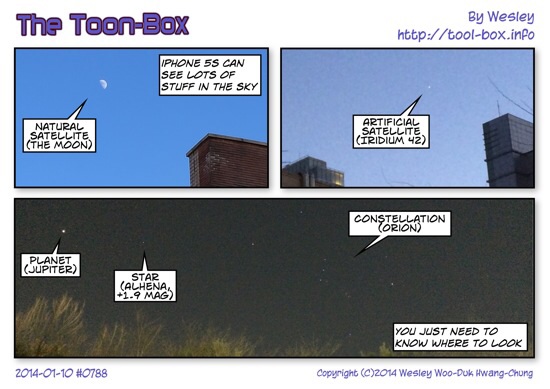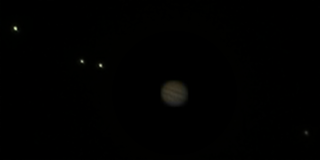Entries tagged as Jupiter
astronomy camera Moon Sanyo VPC-C4 satellite Minolta Dimage X20 binoculars Chuseok telescope eclipse Kodak Z1085 IS star Sun iPhone 4 Canon SX50 HS planet Saturn constellation Lyra lightning ISS iPhone 5S Canon EOS 450D Venus C/2013 R1 Lovejoy comet CHDK smog airplane Boötes Andromeda galaxy flare Iridium Alhena Orion Mars Celine Chung Hayun Chung HT-Mini v2 toy MetOp-A Ursa Minor Leo Minor Ursa Major Raynox DCR-1540PRO teleconverter Vivitar 2.0X iOptron SkyTracker Nikon D3300 Samyang Polar 800mm Toast TP-2 Bode's Galaxy Cigar Galaxy asteroid Ceres dwarf planet Heze Vesta Zeta Virginis Bitgaram City KPX A1522 A1524 iPhone 6 Plus Celestron NexStar 6SE fog Naju Snapzoom Pluto Sony A5000 Josephina Neptune Triton iPhone 6S Plus Milky Way iPhone 7 Plus iPhone X Nikon CoolPix P1000 Uranus Bushnell 8x40 iOS 8 Goheung Naro Space Center travel Bolt EV car electric SpaceX Dragon Jeonju space station Tiangong electric vehicle expressway parking lot service area Boeing Daejeon international spacecraft C/2014 Q2 Lovejoy nebula Taurus focal reducer meteor shower Perseids iPhone 11 Pro Scorpius A1533 AT&T A1530 LTE SK Telecom slow motion fingerprint sensor Touch ID M7 pedometer 3DMark Cortex Camera Geekbench iPhone 3GS iPhone 4S iPhone 5 Kraken Octane performance SunSpider accelerometer compass gyroscope battery charger iOS sound Han-gang river Seoul passcode iPhone 5C iPhone XS China Korea lunar calendar beach firework Ulsan almond nuts walnut Bode’s Galaxy Anex ANH2-065 collimation screw screwdriver Messier 11 Messier 2 T-adapter adapter artificial star LED 2015 TB145 Jeonnam Science Festival A1549 A1586 Canada Hong Kong iPhone 6 Japan T-Mobile USA Verizon KT LGU+ VoIP VoLTE barometer belt case Focus Pixels iPad iPad mini Reachability screen protector Apple Store repair screen Screen Glue Ferris wheel game Goat Simulator iPhone 6+ COEX Fukuoka Fukuoka Airport Incheon International Airport subway leather case Vega LTE-A Osaka A1687 3D Touch A1633 A1634 A1688 iPhone 6S PeaceKeeper Bluetooth Kiwi Fotos KF-8012N Sombrero Galaxy electric fan light trail M&M's OIS Apple Watch baseball Lego Oxford Block App Store IoT lights Philips Hue PSAurora cup holder smartphone mount GPS road iOS 12 iPad Pro 9.7 CarPlay glass KEPCO relocation cabinet electricity EMS K-EMS New EMS Wesley Woo-Duk Hwang-Chung bus monument construction lake park broiled eels eel BHC chicken Mac mini server snow book library Sung-Eun Kim blizzard Lotteria New Year's Day snow angel Cajun Fries Mom's Touch Thigh Burger convenience store KTX-Sancheon meal box KSLV-II Nuri rocket cat pond Singapore Gwangju Muan station train
Keeping an eye on Jupiter
Posted by Wesley on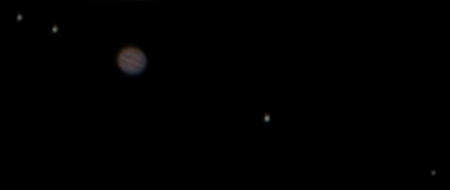
Europa-Io-Jupiter-Ganymede-Callisto
Last Saturday was a pretty good day to see the stars. The smog was lifted and the clouds were barely present during the night. I already made a post about seeing Venus, but I took a look at Jupiter as well. Earth is moving closer to the planet and it'll be at its closest in a month (January 5, 2014), so the view would be nice and big for the next couple of months.
In this composite photo, all four Galilean satellites are present, and the Great Red Spot is visible as a wrinkle in the right end of the lower dark band. 50x magnification on Canon SX50 HS is really at its limit here.
Settings: Canon SX50 HS - 1200mm - f/6.5
Filters: Baader M&S applied
Time: 2013-12-07 22:25 - 22:32 KST
Location: Suwon, Korea
Photos stacked with RegiStax 6.1.0.8
Jupiter: ISO 80 - 1/50s, 19 photos stacked
Satellites: ISO 1600 - 1/5s, 42 photos stacked
ISS passing near Jupiter
Posted by Wesley on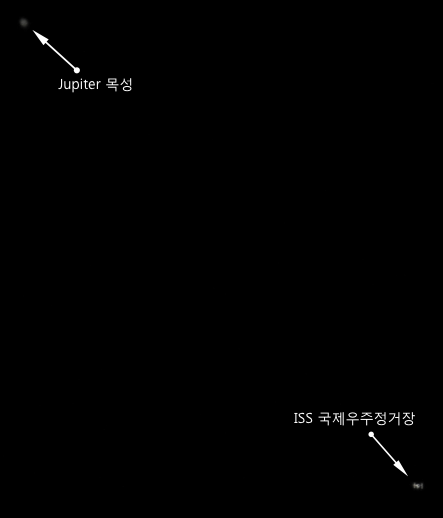
ISS passes near Jupiter
Yesterday's passing of International Space Station had another interesting characteristic. It came within about 0.65 arc degrees of Jupiter at the closest, and I ended up taking both objects at once in several frames. This crop, reduced to 30%, shows one of such instances. You can see that the station looked both larger and brighter than Jupiter.
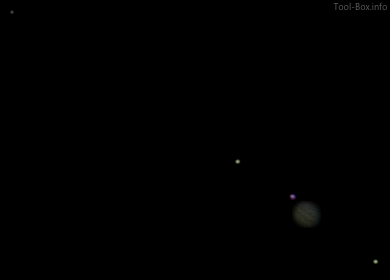
Jovian system
Callisto - Europa - Ganymede - Jupiter - Io
Callisto - Europa - Ganymede - Jupiter - Io
As for Jupiter itself, I photographed its system slightly later. Ganymede was pulling out of Jupiter and was barely visible outside of Jupiter's bright disc.
Time: 2013-11-12 06:02 - 06:23 KST
Top: 1200mm (reduced to 30%) - ISO 80 - 1/640s - 06:02
Bottom: 1200mm, stacked using RegiStax 6.1.0.8
- Jupiter: ISO 80 - 1/320s - 06:20, 7 frames
- Satellites: ISO 800 - 1/10s - 06:23, 27 frames
Location: Suwon, Korea
Getting optimal Jupiter shots w/ SX50 HS
Posted by Wesley on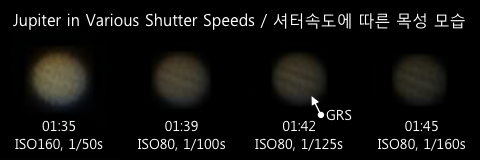
Jupiter photos at various shutter speeds (200% size)
Like it was back in June for Saturn,it would be a good time to get photos of Jupiter for the next couple of months. Earth is getting closer to it, meaning bigger angular diameter (about 41.9" now, and will peak at 46.8" in early January), and it rises high up in the sky during the night, lowering distortion from atmospheric disturbance.
With nature cooperating, I tried various combinations of ISO and shutter speed settings on my Canon SX50 HS to capture distinct cloud bands of Jupiter. Today's sweet spot seemed to be at 1/125s with ISO 80 setting. Too bright or dark, and the bands became hard to tell apart. At the optimal setting, the thickening of the lower band was noticeable, and that's where the Great Red Spot (GRS) was.
And this is a composition of that optimal Jupiter photo over the Galilean satellites I took a few minutes later. The satellites are Ganymede, Europa, Io, and Callisto from left to right. Jovian system was at about 44.8 degrees above horizon and climbing the eastern sky, so it was vertically arranged. The photo was rotated clockwise by 90 degrees to show the system horizontally. Read further for specific settings I used.
Today's Jupiter photo
Posted by Wesley on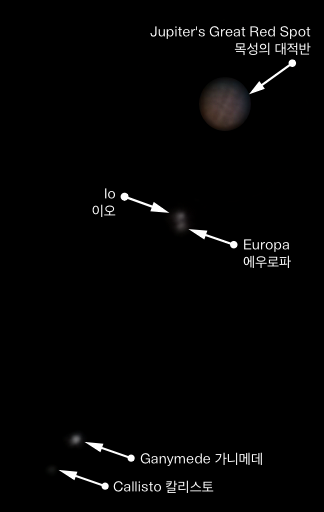
Composites of Jupiter and Galilean moons
Jupiter: 1200mm - ISO 80 - 1/60s - 39 stacked
Satellites: 1200mm - ISO 1250 - 1/10s - 34 stacked
Time/Location: 2013-10-23 00:40 KST / Suwon, Korea
Jupiter: 1200mm - ISO 80 - 1/60s - 39 stacked
Satellites: 1200mm - ISO 1250 - 1/10s - 34 stacked
Time/Location: 2013-10-23 00:40 KST / Suwon, Korea
While waiting for Apple to announce new products (the event took place on 2AM in Korea Standard Time) for 2013 holiday season, I tried another shot at taking photos of Jupiter with SX50 HS while its Great Red Spot was facing Earth. It's still not very discernible even after post-processing, but I think the wrinkle at the right-hand edge is likely to be it.
Incidentally, Io and Europa were visually close together, but the camera was able to distinguish between the two. Maybe I should try to take the photos while Jupiter is higher up in the sky - it should have less atmospheric disturbance. You can see the stacked photos of the planet and the satellites before composition if you keep reading.
